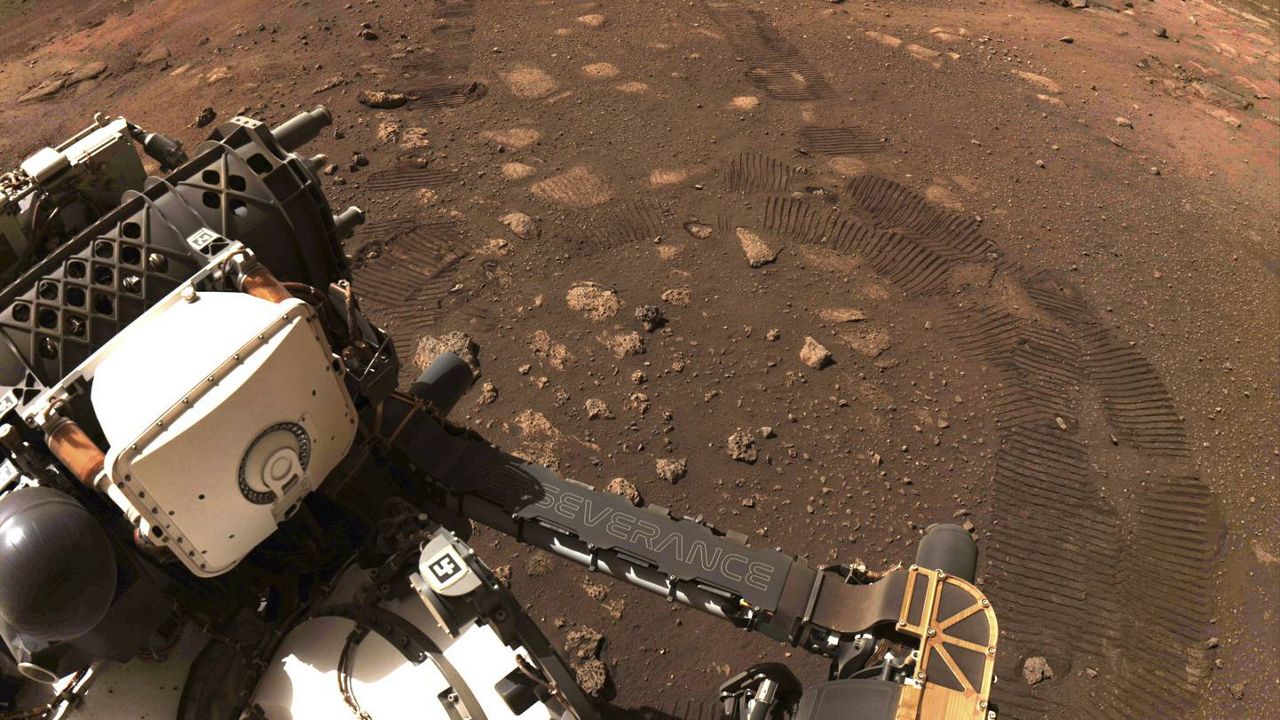PASADENA (CNS) — After two weeks of residency on the Red Planet, the Mars rover Perseverance has taken its first drive, moving about 21 feet in what proved to be a wildly successful test of the rover's mobility, mission managers at Jet Propulsion Laboratory in Pasadena announced Friday.
What You Need To Know
- During the drive, the rover — at a blazing speed of 0.01 mph — moved four meters forward, or about 13 feet
- It then made a 150-degree turn, then moved backward about 2.5 meters, or about eight feet
- The whole process took 33 minutes
- The rover has the capability of moving roughly 200 meters during a Martian day
"Our first drive went incredibly well," said Anais Zarifian, a mobility test bed engineer on the rover mission.
As she showed a photo taken by the rover after moving, Zarifian said, "You can see the wheel tracks we've left on Mars. I don't think I've ever been happier to see wheel tracks, and I've seen a lot of them. This is just a huge milestone for the mission and the mobility team. We've driven on Earth, but driving on Mars is really the ultimate goal. So many people, I can't even count, have worked toward this very moment for years."
According to Zarifian, engineers first ordered the rover's four corner wheels — which are used to manage turns while the vehicle is moving — to rotate 30 degrees.
"It went really well. In certain cases better than we expected," she said. "We saw some performance that in some cases was better than we saw on Earth. It worked beautifully, and we were so excited to move on to the first drive."
During the drive, the rover — at a blazing speed of 0.01 mph — moved four meters forward, or about 13 feet. It then made a 150-degree turn, then moved backward about 2.5 meters, or about eight feet. The whole process took 33 minutes.
"This is really what we've been working toward, and it's just amazing to see," Zarifian said. "I don't think the team could have been happier."
The initial drive occurred Thursday, and Zarifian said more drives were planned on Friday and Saturday. Overall, the rover has the capability of moving roughly 200 meters during a Martian day.
Mission managers are now determining the path the rover will travel to reach a delta within the Jezero Crater, where the rover landed on Feb. 18. Scientists believe the crater once housed a body of water roughly the size of Lake Tahoe. Recent photos taken by the rover showed a variety of rocks, including a mount of layered rocks that mission experts believe were deposited by rivers flowing into the crater.
"We'll explore the delta and eventually winding up at the mouth of the river that once entered Jezero, where we will likely deposit our very first sample depot," said Katie Stack Morgan, deputy project scientist for the mission.
One of the key goals for the Perseverance mission is collecting rock and soil samples that will be deposited on the planet's surface and retrieved by a later mission and returned to Earth.
Meanwhile, Morgan announced that the project team has named the Perseverance landing site on Mars "Octavia E. Butler Landing," in honor of the pioneering Black science-fiction author and Pasadena native.
"Butler's pioneering work explored themes of race, gender, equality and humanity, centering on the experiences of Black women at a time when such voices were largely absent from science fiction," Morgan said. "Butler's protagonists embodied determination and inventiveness, making her a perfect fit for the Perseverance rover mission."
She said Butler "inspired and influnced the planetary science community and many beyond, including those typically under-represented in STEM fields. And the fact that her works are as relevant today, if not more so than when they were originally written and published, is a statement to her vision, genius and timelessness."
Naming the landing site for Butler continues a tradition inaugurated with the 2012 landing of the rover Curiosity on Mars, with that location named in honor of famed sci-fi author Ray Bradbury.
According to Morgan, the designations are "in appreciation of the role science-fiction writers have played in inspiring so many of us to become the engineers, scientists and explorers who turn science fiction into reality for the next generation."



